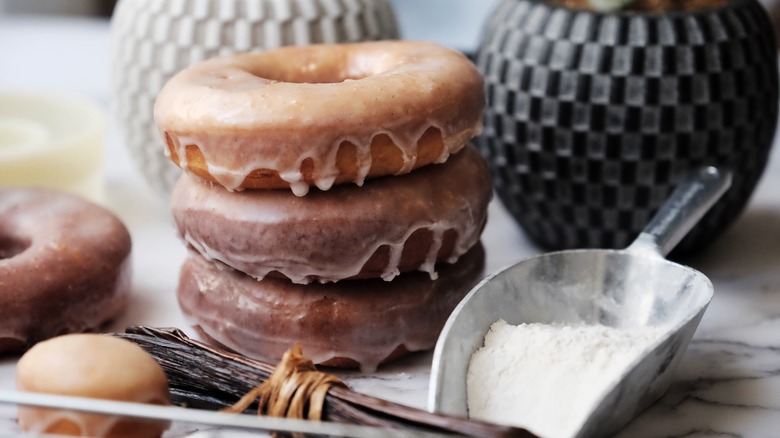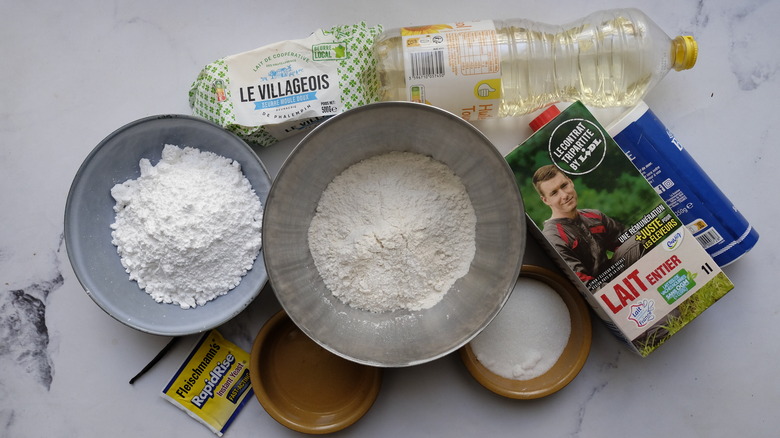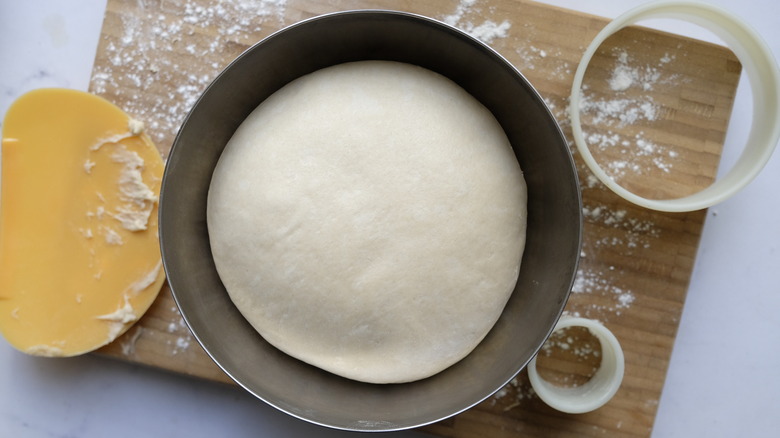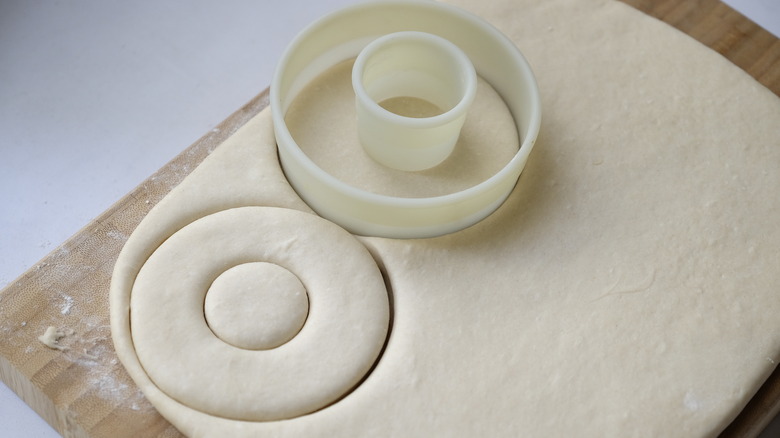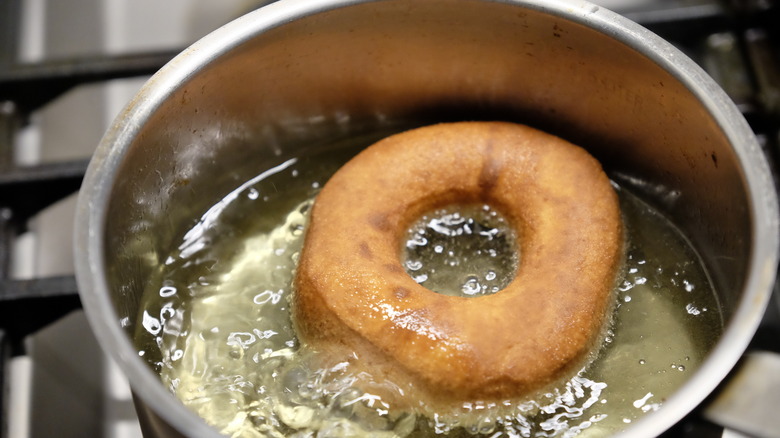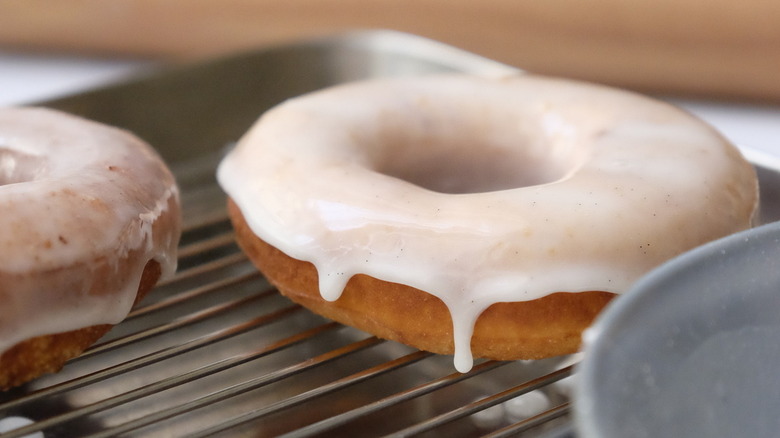Glazed Doughnut Recipe
Recipe developer Eric Ngo is currently living in Paris, something you'd imagine would be a pastry lover's dream come true. As he admits, though, "I miss my American baked goods from time-to-time." It seems that glazed doughnuts are not the kind of thing carried in a typical Parisian patisserie, so Ngo simply makes his own. "What I like about this recipe," he tells us, "is how fast it is to fry up donuts; these fry instantly compared to baking baked goods."
Ngo describes these doughnuts as "fluffy and not too sweet," and says that the time the dough rests before you shape it "will not only improve taste, but make the texture of the dough more workable." He likes to use a vanilla bean to make the glaze "extra special," although he does say that you can use vanilla extract instead if you'd rather. Another option is to supplement or replace the vanilla with a different flavoring extract, such as citrus zest, matcha powder, or cocoa powder.
Gather the ingredients for these glazed doughnuts
For the doughnut dough, you'll need milk, but while Ngo uses whole milk, he says 2% will work, as well. You will also need yeast, flour, butter, granulated sugar, salt, and an egg. For frying the doughnuts, you'll be using quite a lot of oil. Ngo is very specific about the type and amount he uses in this recipe, but he does say "You can also use vegetable, canola oil, or even peanut oil." If you're 1 ounce or so short, that probably won't be a big deal, either — just account for using about 2 quarts of oil.
To glaze the doughnuts, you'll need powdered sugar, corn syrup, and the aforementioned vanilla extract or bean, as well as some additional milk.
Make the doughnut dough
Measure out ¾ cup milk, and beat it with the yeast, flour, butter, white sugar, salt, and egg on medium speed for 10 minutes. If you're using a stand mixer, you should use a dough hook in preference to a paddle or whisk. If you don't have a mixer, though, you can always knead the dough by hand. Ngo tells us "I recommend folding the dough over itself on a lightly floured surface until the dough looks smooth."
Once the dough has been kneaded, drop it onto a lightly-floured surface, and form it into a ball. Put the dough ball into a bowl, cover it with a towel, and let it rest at room temperature for 1 hour.
Shape the doughnuts
Don't waste time cleaning up the floured surface while the dough is resting, since you'll just be using it again. When the dough is done napping, put it back on the floured board or wax paper-covered counter top, and roll it out until it's ½-inch thick. Cut the dough into circles measuring 5 inches in diameter by using a round cookie cutter, drinking glass, or even a knife if you're good at free-handing circles. Once you have 6 dough circles, turn them into doughnuts by cutting 1-inch holes in the centers of each one.
Fry the doughnuts
Heat the oil in a large, sturdy pot until it reaches 375 F, taking care to keep a close eye on the deep fry thermometer, since overheated oil can be a fire hazard. Once the oil is hot enough, carefully drop in the doughnuts, and fry them for 1 minute on each side, or until they are golden brown. You will probably have to do this in batches, since overcrowding the pan will lower the temperature of the oil, and you may wind up with soggy doughnuts. Once the doughnuts are cooked, let them cool on a wire rack.
Glaze the doughnuts and serve
As soon as the last doughnut is done, stir up the glaze by mixing the leftover ¼ cup of milk with the corn syrup, powdered sugar, and vanilla. Dip the warm doughnuts in the glaze, one at a time, then return them to the rack to continue cooling. Once the glaze has hardened, you can turn on the hot light, since the doughnuts are ready to eat.
While the doughnuts are best when eaten fresh, 5 out of 5 doctors would probably tell you it's not a good idea to gobble half a dozen in a single sitting. If you don't have a bunch of other people around to help you eat them, Ngo says "You can also microwave them the next day for 20 seconds to make them soft again if you have leftovers." You can also help the doughnuts stay fresh for longer by storing them in an airtight container, refrigerating them, or even freezing them.
Glazed Doughnut Recipe
Master classic glazed doughnuts by simply frying up rings of yeasted dough, and coating them in a sweet vanilla glaze.
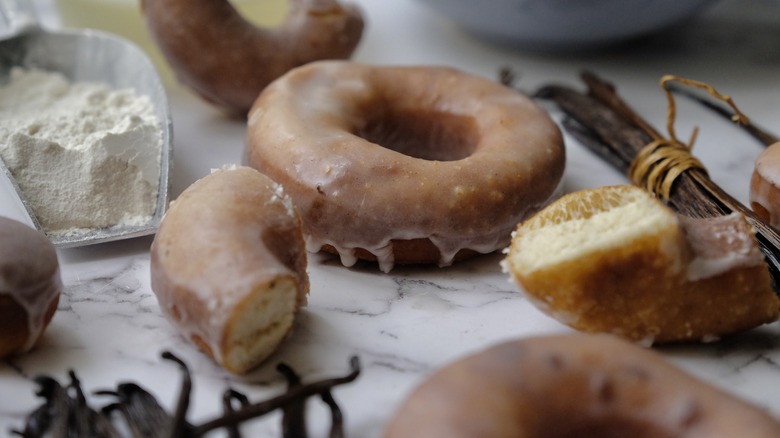
Ingredients
- 1 cup whole milk at room temperature, divided
- 2 teaspoons instant yeast
- 2 ¼ cups all-purpose flour
- ¼ cup unsalted butter, softened
- ⅓ cup granulated sugar
- 1 teaspoon salt
- 1 egg
- 33 fluid ounces sunflower oil for frying
- 1 ½ cup powdered sugar
- 1 tablespoon corn syrup
- 1 teaspoon vanilla extract or ½ vanilla bean
Directions
- Beat ¾ cup milk with the yeast, flour, butter, white sugar, salt, and egg on medium speed for 10 minutes. You can also knead it by hand until smooth.
- Turn the dough out onto a lightly-floured surface, and shape it into a ball. Put the dough in a bowl, and cover it with a kitchen towel. Let the dough rest at room temperature for 1 hour.
- Return the dough to the floured surface, and roll it out until it's ½-inch thick. Cut the dough into 6 5-inch circles, and then cut 1-inch holes in the center.
- Heat the oil over medium heat to 375 F. Fry each doughnut for around 1 minute on each side, or until golden brown, working in batches if necessary to avoid overcrowding. Cool the donuts on a wire rack.
- Mix the remaining ¼ cup of milk with the powdered sugar, corn syrup, and vanilla, stirring until smooth. Dip each doughnut into the glaze, then return to the cooling rack until the glaze hardens.
